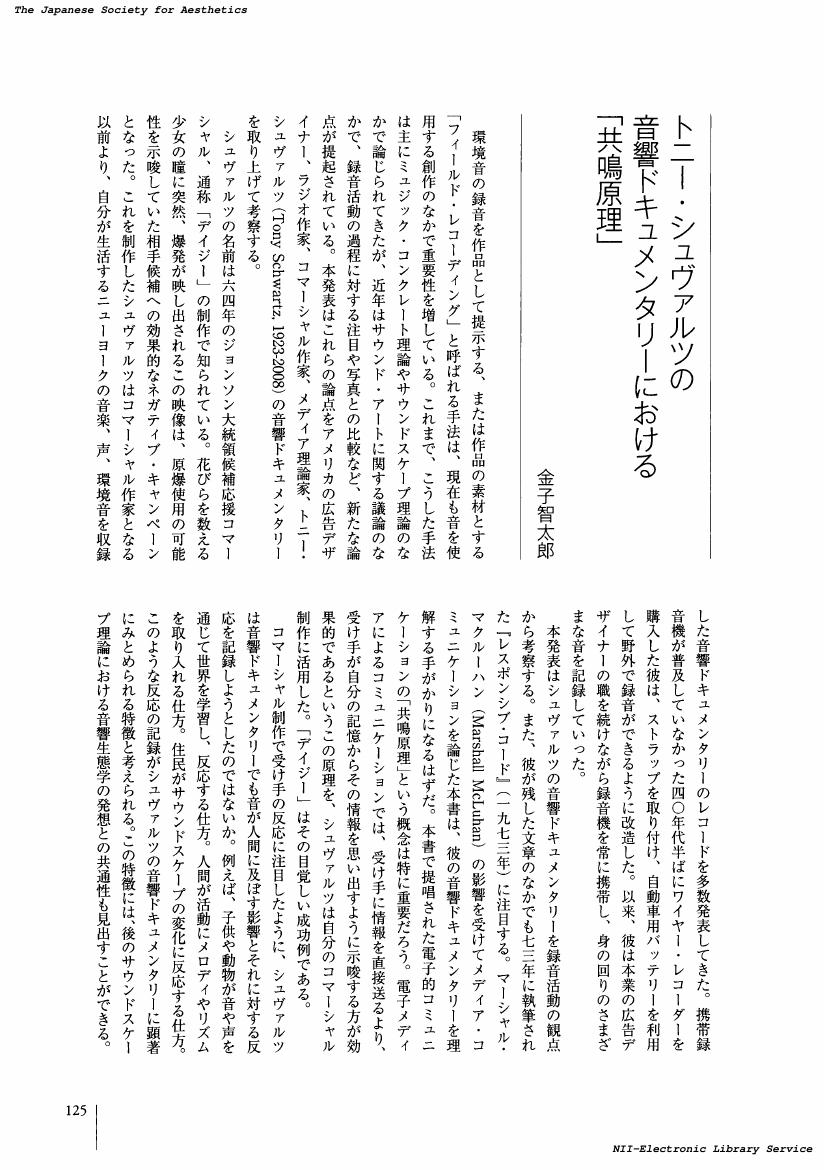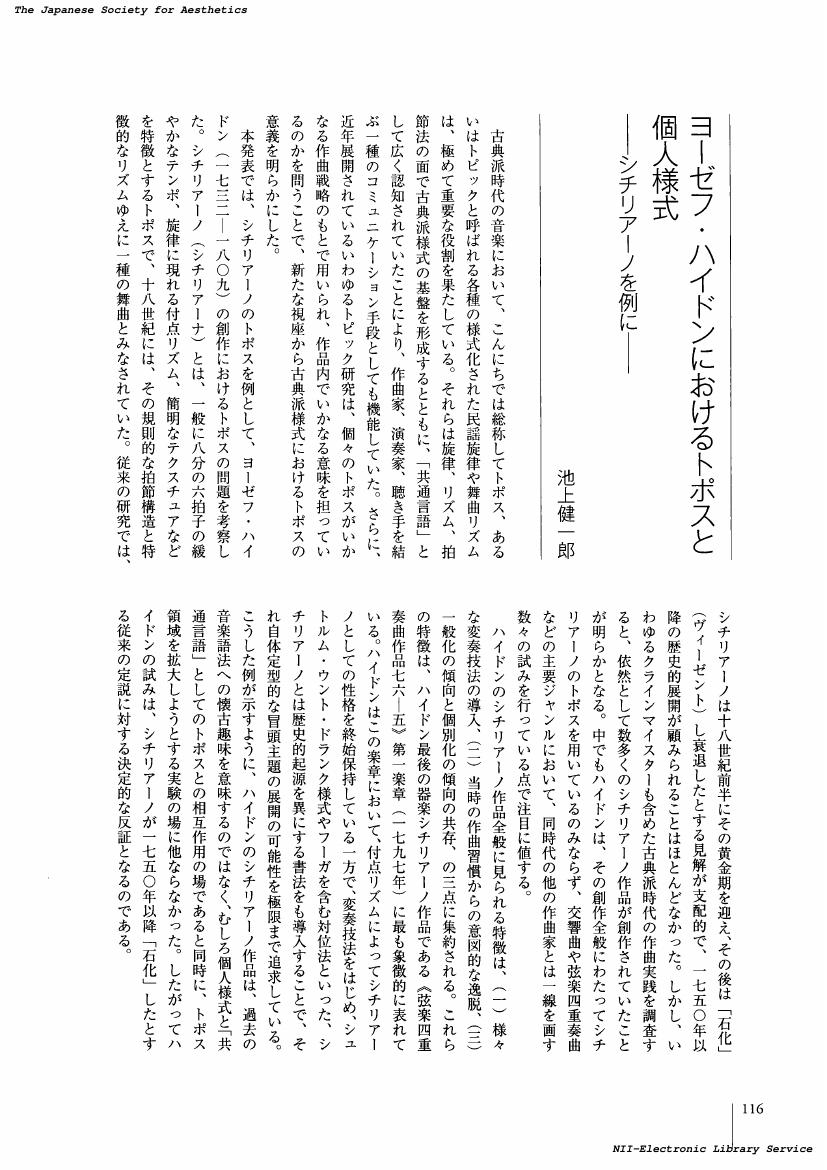- 著者
- 伊藤 麻衣
- 出版者
- 美学会
- 雑誌
- 美学 (ISSN:05200962)
- 巻号頁・発行日
- vol.63, no.2, pp.119, 2012-12-31 (Released:2017-05-22)
- 著者
- 江藤 匠
- 出版者
- 美学会
- 雑誌
- 美学 (ISSN:05200962)
- 巻号頁・発行日
- vol.63, no.2, pp.120, 2012-12-31 (Released:2017-05-22)
- 著者
- 大前 美由希
- 出版者
- 美学会
- 雑誌
- 美学 (ISSN:05200962)
- 巻号頁・発行日
- vol.63, no.2, pp.122, 2012-12-31 (Released:2017-05-22)
- 著者
- 小澤 京子
- 出版者
- 美学会
- 雑誌
- 美学 (ISSN:05200962)
- 巻号頁・発行日
- vol.63, no.2, pp.123, 2012-12-31 (Released:2017-05-22)
1 0 0 0 OA エージェンシーとインデックスの芸術論(第六十三回美学会全国大会発表要旨)
- 著者
- 加藤 隆文
- 出版者
- 美学会
- 雑誌
- 美学 (ISSN:05200962)
- 巻号頁・発行日
- vol.63, no.2, pp.124, 2012-12-31 (Released:2017-05-22)
- 著者
- 金子 智太郎
- 出版者
- 美学会
- 雑誌
- 美学 (ISSN:05200962)
- 巻号頁・発行日
- vol.63, no.2, pp.125, 2012-12-31 (Released:2017-05-22)
1 0 0 0 OA 複製技術における形象的なもの : ポール・リシェによる身体の形象化について
- 著者
- 増田 展大
- 出版者
- 美学会
- 雑誌
- 美学 (ISSN:05200962)
- 巻号頁・発行日
- vol.63, no.2, pp.37-48, 2012-12-31 (Released:2017-05-22)
Au debut de XX^e siecle, Paul Richer, un professeur d'anatomie artistique, a identifie un crane decouvert au musee de l'homme comme etant celui de Rene Descartes qui avait disparu depuis 1650. Cette identification n'a pu se faire qu'en maniant les diverses techniques de reproduction comme le dessin, la photographie et le moulage. Cet article se propose donc d'examiner le procede de figuration du corps de Richer a travers la conception du <<figural>> avancee par Jean-Francois Lyotard darts Discours, Figure. Depuis les annees 1990, la problematique du figural, situee a un niveau virtuel entre langage et figure, provoque des polerniques dans les domaines de l'histoire de l'art, du cinema et des nouveaux media numeriques. Ce concept permet de debattre des proprietes ephemeres et virtuelles des images trans-mediatiques. Cependant, cela porte le risque de tomber dans la supposition d'une attitude passive et dans le manque d'analyse technique. En examinant le procede de Richer, qui analyse et modele le corps imaginaire, it faut donc d'une part verifier le figural contenu dans les processus virtuels des technologies reproductives variees, et d'autre part, presenter sa valeur au debut du XX^e et du XXI^e siecle.
1 0 0 0 OA アフリカ芸術の刷新とフランス植民地行政 : ジョルジュ・アルディの「黒人芸術」論を中心に
- 著者
- 柳沢 史明
- 出版者
- 美学会
- 雑誌
- 美学 (ISSN:05200962)
- 巻号頁・発行日
- vol.63, no.2, pp.49-60, 2012-12-31 (Released:2017-05-22)
En accordant une place nouvelle aux ouvrages de Georges Hardy, administrateur colonial de la premiere moitie du XXe siecle, cet article reconstitue la relation entre le colonialisme francais et l'art en Afrique noire. Sur la base de l'interet tant pour le contexte qui lui etait contemporain que pour la perspective, Hardy affirme qu'il reste des possibilites de renouvellement des <<arts indigenes>> malgre leur disparition brutale apres l'installation de la domination europeenne. Dans son livre L'Art negre en 1927, il identifie les influences europeennes a la fois negatives et positives, et il conclut que c'est dans l'avenir qu'on pourra apprecier les effets de cette influence europeenne sur les arts africains et sa contribution a leur developpement, comme le Benin ou le Dahomey, ou etaient produites les sculptures de qualite et liberties de la tradition religieuse. La colonialisation francaise chez Hardy se voit attribuer un role important d'aider les activites creatrices a se developper, ce qui permettrait aux colonies de collaborer et de s'associer a la metropole au travers l'eveil des arts indigenes. G. Hardy justifie ainsi l'attitude paternaliste du colonialisme qui par l'acculturation a permis aux arts africains de s'ouvrir a d'autres domaines artistiques comme la peinture.
1 0 0 0 OA アドルフ・ロースにおける素材と空間 : ツァラ邸以降の家屋建築を中心として
- 著者
- 岸本 督司
- 出版者
- 美学会
- 雑誌
- 美学 (ISSN:05200962)
- 巻号頁・発行日
- vol.63, no.2, pp.61-72, 2012-12-31 (Released:2017-05-22)
Dieser Aufsatz versucht, die verschiedene Effekte, die die Materialien in den Raumen der Werke von Adolf Loos produzieren, ins Klare zu bringen. Loos entwarf in seinen letzten Lebensjahren mehrere Hauser nach seiner charakteristischen Begriffe, Raumplan. Laut seines fruhereren Aufsatz, Das Prinzip der Bekleidung, wahlte er bei den Entwurfen zuerst das Material fur Bekleidung fur Raume seines Architektur aus, um einen warmen, wohnlichen Raum herzustellen. Und dann uberlegte er die Struktur, die dieses Material tragt. Auch der Entwurf von Hausern von Raumplan kann mit seinem Material verbunden werden. Aber Raumplan widerspricht dem Prinzip der Bekleidung wegen der Flussigkeit zwischen verschiedenen Raumen, die er produziert. Dieser Aufsatz betrachtet das Gefuhl des Schutzes, das die Bewohner durch Materialien bei verschiedenen Hohen in den Raumen des Raumplans bekommen, um seine Methode fur Behandlung dieses Widerspruch zu analysieren. Ausserdem wird auch der gleiche Effekt in den isolierenden Einzelzimmern in Betracht gezogen. Des weiteren kommt die Betrachtung uber Beziehung von Bekleidung der Wanden zum Raum. Diese Bekleidung gibt keinen statischen Eindruck, weil dahinter anderes Zimmer oder Schrank verborgen werden. Diese Besonderheiten seiner Materialien haben nicht nur mit Aussehen zu tun, sondern auch mit seiner Struktur des Raumplans oder mit seiner archtektonischen Idee.
- 著者
- 江口 みなみ
- 出版者
- 美学会
- 雑誌
- 美学 (ISSN:05200962)
- 巻号頁・発行日
- vol.63, no.2, pp.73-84, 2012-12-31 (Released:2017-05-22)
In 1929, the Deutscher Werkbund held the exhibition Film und Foto in Stuttgart to herald the stylistic revolution from pictorialism to the New Photography. This monumental exhibition later toured internationally, and its selection reached Tokyo and Osaka in 1931. Published research interprets this event as the first opportunity for Japanese modernists to view original works of the New Photography. However, it is also necessary to consider the radical format of the exhibition, as conceived by El Lissitzky and Laszlo Moholy-Nagy, who employed techniques of presentation from graphic design and architecture. Through the examinations of the displays of these exhibitions and subsequent cases, I would like to illustrate how the concept and technique of exhibition design developed in Japan under the influence of its precedents in Germany in the 1930s. The related materials represent that the form of the Film und Foto in Japan remained conservative. However, the idea of innovative forms of display soon developed, such as the design of NOJIMA Yasuzo's solo exhibition by HARA Hiromu in 1933, because the articles on the German magazines or the reports from Japanese Bauhausler YAMAWAKI Iwao provided Japanese modernists with a new model for considering exhibition space and opened up alternative possibilities of display.
1 0 0 0 OA イーリ大聖堂袖廊の建築
- 著者
- 愛宕 出
- 出版者
- 美学会
- 雑誌
- 美学 (ISSN:05200962)
- 巻号頁・発行日
- vol.63, no.2, pp.85-96, 2012-12-31 (Released:2017-05-22)
Generally accepted chronology of Ely cathedral has an inconsistency. While the choir is considered to have been entered in 1106, the "Monks' Door" is dated in 1120 at the earliest. We suggest that the choir is then situated in the east wing (in the same place as the choir of Durham), until the space under the crossing would be arranged around 1120. During the vacancy of abbot (1093-1200), the church architecture was managed by monks with scanty funds. They constructed three aisles of the south transept. These offered them the space for monastic routine activity and the passageway from the western door of south transept to the eastern choir. In this situation the cross aisle of south transept had an important roll. On the other hand, the cross aisle of north transept was not realized. At the north-east corner there was a change of workshop. This reflects the recovery of monastic funds in about 1106. The turning point was pier N3E, which introduced vertical elements to the pier design.
- 著者
- 秋庭 佳代子
- 出版者
- 美学会
- 雑誌
- 美学 (ISSN:05200962)
- 巻号頁・発行日
- vol.63, no.2, pp.114, 2012-12-31 (Released:2017-05-22)
- 著者
- 安部 孝典
- 出版者
- 美学会
- 雑誌
- 美学 (ISSN:05200962)
- 巻号頁・発行日
- vol.63, no.2, pp.115, 2012-12-31 (Released:2017-05-22)
- 著者
- 池上 健一郎
- 出版者
- 美学会
- 雑誌
- 美学 (ISSN:05200962)
- 巻号頁・発行日
- vol.63, no.2, pp.116, 2012-12-31 (Released:2017-05-22)
- 著者
- 山下 尚一
- 出版者
- 美学会
- 雑誌
- 美学 (ISSN:05200962)
- 巻号頁・発行日
- vol.63, no.2, pp.13-24, 2012-12-31 (Released:2017-05-22)
Nous nous proposons dans cet article, en analysant <<L'esthetique du discontinu dans la musique nouvelle>> de Gisele Brelet, d'examiner la temporalite chez Bergson, Bachelard et Brelet. Cette genealogie du temps, Bergson-Bachelard-Brelet, nous montre une nouvelle lecture de l'esthetique musicale de Gisele Brelet. Nous essaierons d'abord de constater dans les arguments brelettiens la transition de l'esthetique de la continuite de la musique tonale a celle de la discontinuite de la musique atonale, c'est-a-dire transition du concept de la duree bergsonienne a celui de l'instant bachelardien. Ensuite, nous nous interesserons au probleme de la continuite profonde que Brelet repere fmalement dans le temps musical. Nous chercherons de la, en comparant les theories du temps chez Bergson, Bachelard et Brelet, a reinterpreter l'esthetique du discontinu de Brelet. Notre examen revelera enfin le temps musical paradoxal qui est a la fois duree et instant, temps qui consiste precisement en duree instantanee.
- 著者
- 渡辺 裕
- 出版者
- 美学会
- 雑誌
- 美学 (ISSN:05200962)
- 巻号頁・発行日
- vol.63, no.1, pp.186, 2012-06-30 (Released:2017-05-22)
- 著者
- 石井 祐子
- 出版者
- 美学会
- 雑誌
- 美学 (ISSN:05200962)
- 巻号頁・発行日
- vol.63, no.1, pp.187, 2012-06-30 (Released:2017-05-22)
- 著者
- 青木 加苗
- 出版者
- 美学会
- 雑誌
- 美学 (ISSN:05200962)
- 巻号頁・発行日
- vol.63, no.1, pp.188, 2012-06-30 (Released:2017-05-22)
- 著者
- 大愛 崇晴
- 出版者
- 美学会
- 雑誌
- 美学 (ISSN:05200962)
- 巻号頁・発行日
- vol.63, no.1, pp.133-144, 2012-06-30 (Released:2017-05-22)
Thomas Willis (1621-1675) was an English physician and anatomist who was famous for pioneering the neuroscience. He worked on the intracerebral causes of musical faculty or the "musical ear" in his book Cerebri anatome ("The Anatomy of the brain," 1664). According to Willis, the musical memory is stored in the cerebellum, which takes charge of the involuntary movements that are indispensable for life support, and is released by singing. A melody that has been heard once can be sung correctly without recalling because of this structure of musical memory. Later, Thomas Salmon, a contemporary musical theorist, asserted that the hearing capable of recognizing musical pleasure was different from the ordinary hearing that perceives general sound. Further, he referred to Willis's theory concerning the cause of that special hearing. In the eighteenth century, Salmon's idea was seconded by Francis Hutcheson, who supposed that it was an "internal sense," not an external sense (i.e., ordinary hearing), that perceived the pleasure of musical beauty. The "internal sense," which was identified with "taste," had a lot in common with Willis's "musical ear" in terms of the immediacy of judgment. Therefore, Willis's view on hearing could be understood as a possible explanation of musical "taste."
- 著者
- 山口 真季子
- 出版者
- 美学会
- 雑誌
- 美学 (ISSN:05200962)
- 巻号頁・発行日
- vol.63, no.1, pp.145-156, 2012-06-30 (Released:2017-05-22)
Der Komponist Ernst Krenek hat mit den Pianisten Artur Schnabel und Eduard Erdmann, die oft in ihren Konzerten Schuberts Klaviermusik spielten, zur Neubewertung der Werke Schuberts beigetragen. Krenek hat mit "dem fanatischen Schubert Verehrer" Erdmann alle Lieder Schuberts durchforscht und ausserdem Schuberts unvollendete Klaviersonate in C-dur auf Anregung von Erdmann erganzt. So zahlt diese Erganzung zu einem der bedeutenden Beispiele ihrer Neubewertung. In dieser Studie mochte ich untersuchen, welche Punkte Krenek an Schuberts Kompositionstechnik schatzte und wie er sie auf seine Erganzung anwendete. Durch die Analyse der erganzten Sonate und den Vergleich mit Kreneks Erklarung seiner Erganzungsidee sowie der Struktur der Sonate (1947) habe ich klar gemacht, was fur Krenek das charakteristische an Schuberts Musik ist. Krenek hat in seiner Erganzung Schuberts feinen Sinn der musikalischen "Ausbalancierung" und seine Technik der vielfaltigen "Varianten" angewendet. Andererseits vermied er ubermassige Umformung der Melodien und harmonische Uppigkeit. Krenek hat in dieser Erganzung eine neue Schubert-Interpretation vorgezeigt.











